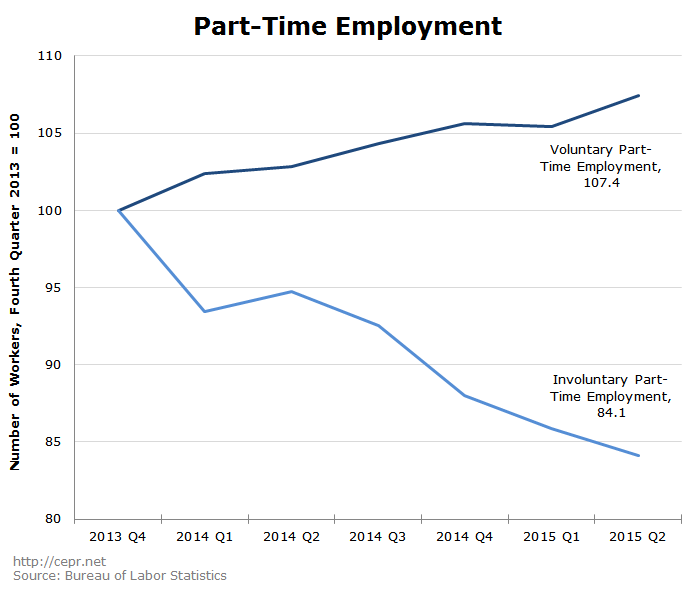July 09, 2015
Last week CEPR Co-Director Dean Baker commented on one of the more positive aspects of June’s jobs report:
“One clear positive is that the number of people voluntarily working part-time rose sharply even as the number of people involuntarily working part-time fell…This is undoubtedly due in large part to the ACA which freed workers from the need to get insurance through their employer.”
There’s good reason to think the Affordable Care Act (ACA) could be leading to greater voluntary part-time employment. To explain: if an employee is working part-time and would like to work full-time, his or her status as part-time is a negative; that employee would like to work more, but hasn’t been given the opportunity to do so. However, if an employee is voluntarily working part-time, it means that he or she is making an active decision to pursue part-time employment. Since health insurance was linked to a worker’s status as a full-time employee before the ACA went into effect, many Americans worked full-time simply to receive health insurance benefits; this was true even for workers who otherwise would have preferred to work part-time. Thanks to the ACA, workers no longer have to work full-time in order to receive insurance, meaning they can work fewer hours if they want to, assuming they can still pay the bills.
This is a different story than the one told by the ACA’s critics, who have frequently asserted that the ACA is leading firms to cut workers’ hours. According to this view, the rise of part-time work is a negative: workers who would like to work full-time are having their hours cut and are now working part-time involuntarily.
In assessing these two tales, I’ve previously presented graphs showing monthly changes in both voluntary and involuntary part-time employment since the ACA went into effect. However, now that the ACA’s exchanges and Medicaid expansion have been in effect for 1.5 years (six quarters), I’m transitioning to quarterly numbers to smooth out the data and avoid monthly fluctuations. The new graph, which indexes the number of voluntary and involuntary part-time workers to 100 for the fourth quarter of 2013—the last quarter before people gained insurance under the ACA—can be seen below.

Since the fourth quarter of 2014, voluntary part-time employment is up 7.4 percent, while involuntary part-time employment is down 15.9 percent. Notably, the single greatest quarterly jump in voluntary part-time employment came in the first quarter of 2014, right when the ACA went into effect. Between the last quarter of 2013 and the first quarter of 2014, voluntary part-time employment went up 2.4 percent; it has only continued increasing since then. Instead of forcing firms to cut workers’ hours, the ACA merely appears to have given workers the freedom to work the type of schedules they find desirable. This is a win for working parents, older workers, and the American workforce more generally.






